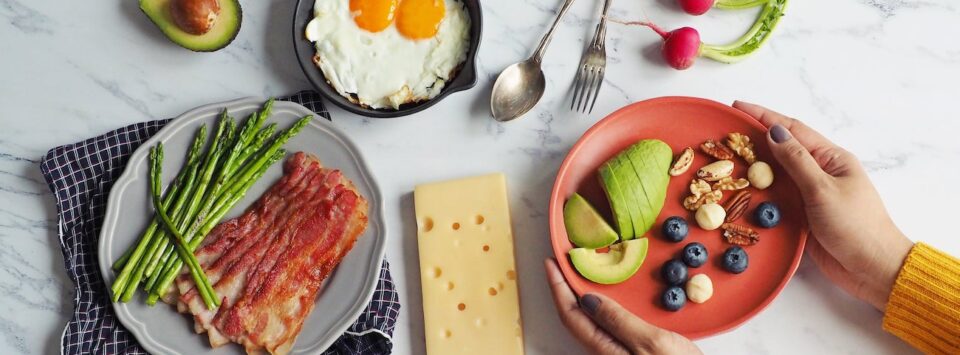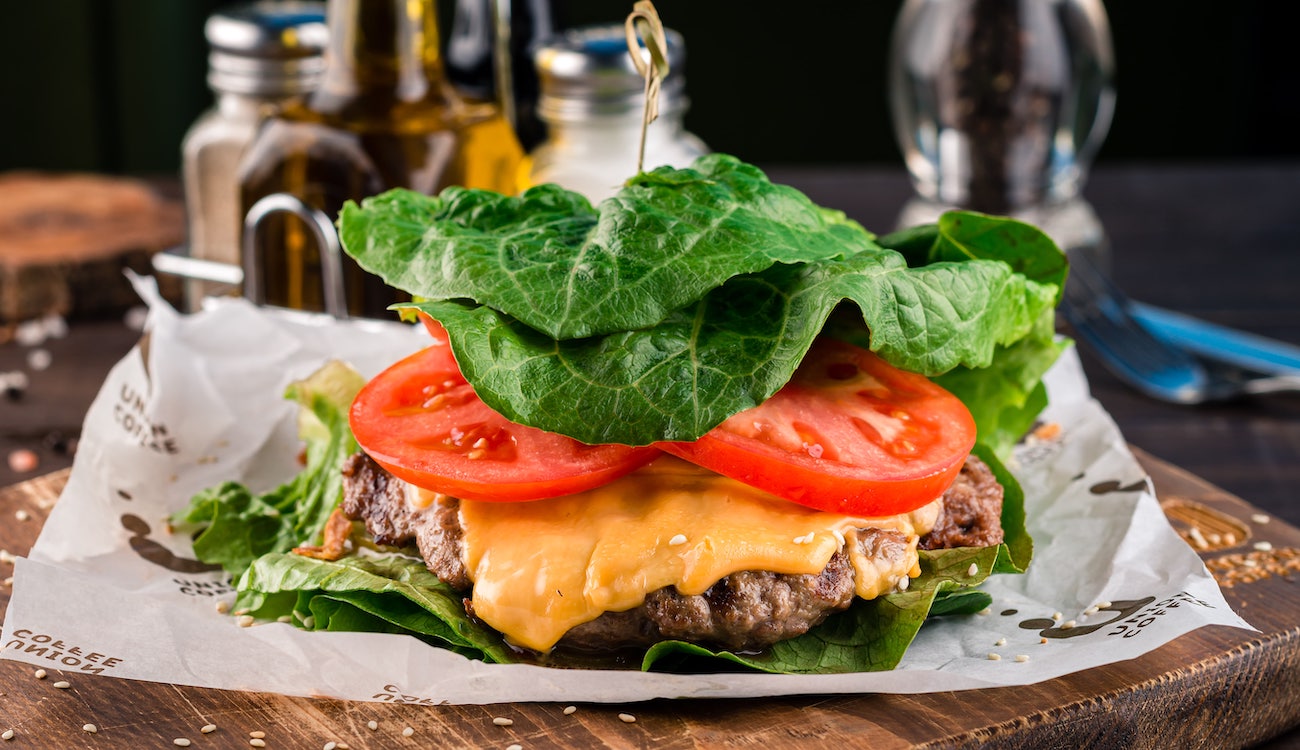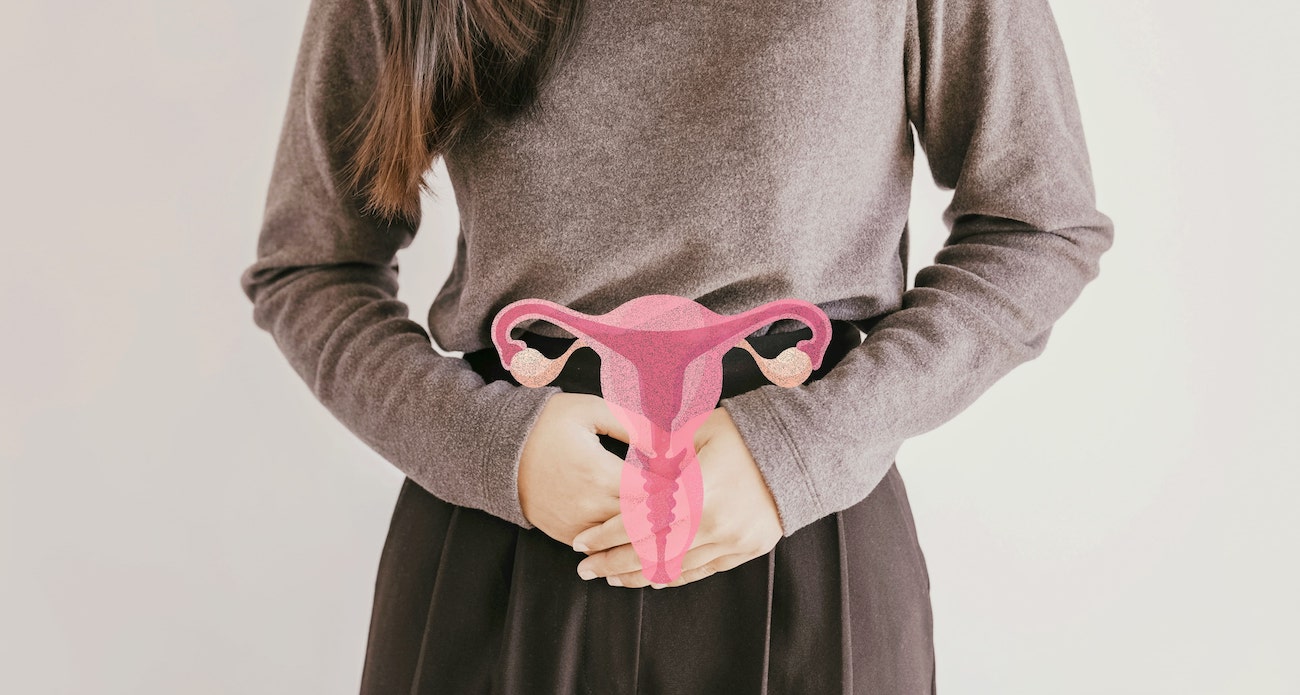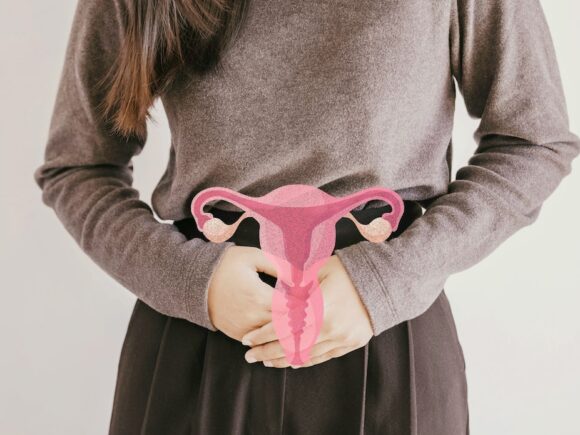Free Keto Beginner‘s Guide: Learn How to Start Keto Diet


Making the decision to change your diet is the first step toward better health and weight loss. However, if you’re going to succeed in making lasting changes, you need to know why you are including certain foods and cutting out others and how to do it safely.
The keto diet is vastly different from the average American diet. You probably already know that the ketogenic diet is a low-carb diet, but did you know that it is distinctive from other low-carb diets because you also need to increase your intake of healthy fats?
The best way to start the keto diet is to do your research and learn about what you must eat and what you should avoid. You should also understand why you are making these adjustments to your diet to avoid making mistakes that result in your ketogenic diet being ineffective.
We want you to succeed. Therefore, this detailed keto diet for beginners guide teaches you everything you need to know about starting the ketogenic diet to lose weight and gain health. Use it to create your own keto diet plan so that you can enjoy all the benefits of the keto lifestyle.
What Is the Keto Diet?
The ketogenic diet is a low-carb diet. However, unlike other low-carb diets, it is also a high-fat diet. The keto diet involves strictly limiting your carb intake and replacing calories with healthy fats.
It’s important to note that the ketogenic diet is not a high-protein diet. Although it may be tempting to increase the amount of protein you eat in place of carbohydrates, protein intake is moderate. The goal is to eat enough protein to meet your body’s requirements for amino acids that are used to build muscle and other structures in the body.
Protein is not intended as a source of energy. If you eat too much protein, your blood sugar levels rise, which is counterproductive in keto.
Typically, the cells of your body use glucose from carbs and sugars for energy. However, a low-carb, high-fat intake, combined with moderate consumption of protein, forces your body to adapt and change the type of fuel it uses for energy.
Low-carb diets, such as the ketogenic diet plan, result in lower blood sugar levels. Therefore, in order to ensure that your body has enough energy to stay alive, fat is converted to ketone bodies in the liver, and the ketone bodies are burned for energy by the cells.
Keto diets have many benefits. One of the main reasons for starting the keto diet is weight loss. However, ketogenic diets have a long history for the treatment of medical conditions. It was first used to manage epilepsy, and more recently, it has been proven to be effective in the management of cancer, diabetes, and Alzheimer’s disease.

This beginner’s guide will show you how to start the keto diet at home for free so that you can lose weight, feel more energized, and improve your metabolic health. You will learn how to limit your carbohydrates without feeling hungry and train your body to burn fat for energy.
Types of keto diets
There are 4 main types of ketogenic diets. The standard keto diet is the one used most frequently for weight loss and metabolic health. It is a very low-carb diet with a high fat content and a moderate amount of protein.
A high-protein ketogenic diet is used by athletes and bodybuilders. It has a higher protein content and an even lower net carb content.
The cyclical ketogenic diet and the targeted ketogenic diet involve eating more carbohydrates on certain days. For example, when you follow a cyclical keto diet, you are allowed to eat carbs on weekends, and the targeted keto diet allows you to eat more carbohydrates before or after exercise.
A beginner keto diet is usually the standard version of the keto lifestyle. By consistently limiting your carbs, it is easier to make the transition from your body being a glucose-burning machine to an efficient fat-burning machine.
What to eat on keto
The first question people ask when starting the keto diet is, what can you eat on the keto diet? Although many of the foods allowed on a low-carb diet are the same, your food choices are significantly different from those on a standard American diet.
It may feel a bit daunting at first when you decide to cut out carbs. However, there is a wide range of delicious low-carb foods you can eat on keto, and if you focus on what you can have, you are less likely to miss the foods you can’t have. A good cheat sheet is the keto food pyramid that can help you assemble balanced keto meals.
The following foods can be enjoyed on the keto diet plan:
Protein:
- Beef (preferably grass-fed)
- Pork (including bacon and ham)
- Lamb
- Chicken
- Turkey
- Fish and seafood (including salmon, trout, tuna, sardines, shrimp, lobster, crab, and mussels)
- Eggs
Dairy products:
- Butter
- Ghee
- Heavy cream
- Cheese (such as cheddar, mozzarella, feta, ricotta, and cream cheese)
- Greek yogurt (unsweetened)
Healthy fats:
- Avocado
- Avocado oil
- Olive oil
- Coconut oil
- MCT oil
- Nuts (including macadamia nuts, almonds, walnuts, and pecans)
- Seeds (including flaxseeds, chia seeds, and pumpkin seeds)
Low-carb vegetables:
- Leafy greens (including spinach, kale, lettuce, and arugula)
- Broccoli
- Cauliflower
- Zucchini
- Brussels sprouts
- Cabbage
- Asparagus
- Bell peppers
- Mushrooms
- Green beans
- Eggplant
- Cucumber
- Tomatoes
Berries:
- Strawberries
- Raspberries
- Blackberries
Beverages:
- Water
- Unsweetened tea (including green tea, black tea)
- Coffee (black or with added cream/milk, no sugar)
Herbs, spices, and condiments:
- Salt
- Pepper
- Garlic
- Ginger
- Turmeric
- Cinnamon
- Basil
- Oregano
- Rosemary
- Cilantro
- Vinegar
- Mustard
- Hot sauce (without added sugars)
To limit your carb intake, it’s necessary to avoid all starchy foods and those with added sugars. Eating them will drastically push up your net carb intake and make it impossible to maintain ketosis.
The following foods should be avoided on the ketogenic diet:
Starchy foods:
- Wheat-based products (including bread, pasta, and breakfast cereals)
- Rice
- Quinoa
- Oats
- Corn
- Barley
- Rye
Sugary foods:
- Sugar (including white sugar, brown sugar, and cane sugar)
- Honey
- Maple syrup
- Agave syrup
- High-fructose corn syrup
- Desserts (including cakes, cookies, pastries, and ice cream)
- Chocolates and candies
- Soft drinks
- Fruit juices
Fruits:
- Bananas
- Apples
- Oranges
- Grapes
- Pineapple
- Mangoes
- Pears
Legumes and beans:
- Chickpeas
- Lentils
- Black beans
- Kidney beans
- Peas
Starchy vegetables:
- Potatoes
- Sweet potatoes
- Carrots
- Parsnips
- Turnips
- Beets
Processed and packaged foods:
- Processed meats (including hot dogs, sausages, and deli meats with added sugars and fillers)
- Packaged snacks (including chips and crackers)
- Fast food (burgers, fries, and pizza)
Unhealthy fats and oils:
- Vegetable oils (including soybean oil, corn oil, and sunflower oil)
- Margarine
- Hydrogenated oils
- Trans fats
Alcohol:
- Beer
- Sweet wines
- Cocktails with sugary mixers
Keto Macros: Carbs, Protein, and Fats,
Keeping track of your macronutrient intake is the key to success when following the ketogenic diet.
Macronutrients, or macros for short, are the nutrients in your food that provide your body with energy. They include carbohydrates, protein, and fat.
The following is the macronutrient breakdown for the standard ketogenic diet:
- Carbohydrates: 5–10% of your total calorie intake
- Protein: 25–30% of your total calorie intake
- Fat: 70–80% of your total calorie intake
Carbohydrates
All carbohydrate foods are broken down into simple sugars when they are digested and released into your blood as glucose. In response to the rise in blood sugar, insulin is released from the pancreas, and it is used to unlock the cells and allow the glucose to move into the cells, where it is burned for energy.
If there is more sugar in your blood than your body needs, it is converted to fat and stored, resulting in weight gain.
Too much sugar also means there is more insulin than necessary in your blood. Persistently high insulin levels may cause your body to become less sensitive to insulin and result in insulin resistance which, in turn, makes weight loss more difficult and is associated with the development of diabetes and cardiovascular disease.
When you limit your carbohydrate intake, such as on the keto diet, your blood sugar and insulin levels are better controlled, and your cells have to adapt to an alternative fuel source – fat.
Net carbs
You will have come across the term “net carbs” while researching the keto diet. What does it mean?
Carbohydrates include starches, sugars, and fiber. Since your body is incapable of breaking down dietary fiber, it does not contribute to your overall carb intake. Therefore, the fiber content of foods can be subtracted from the total carbohydrate content.
The new total is referred to as net carbs. Since only starches and sugars contribute to your sugar load, keto diets frequently refer to the carbohydrate content in your diet as net carbs per day.
The goal is to consume less than 50g of net carbs per day when you are following the keto diet.
Protein
Your keto diet plan includes a moderate amount of protein to meet your body’s protein requirements to maintain structure and function. Each gram of protein provides the same amount of energy as a gram of carbohydrate (4kcal).
If there is insufficient energy in your diet, protein will be converted to glucose in a process called gluconeogenesis. Therefore, if your protein intake is too high, you risk raising your blood glucose levels. This makes it impossible to maintain ketosis even though the amount of sugar released is less than that released from carbs.
Fats
You can prevent your protein from being converted to sugar by increasing your fat intake. In fact, eating more fat on the keto diet is just as important as limiting your carbohydrates.
The calorie deficit you create by restricting carbs in your diet needs to be replaced so that your body still has enough energy to function. On the keto diet, those calories are replaced with fat.
Dietary fat is converted to ketone bodies in the liver, which are transported to the cells, where they are burned for energy instead of glucose.
It can be overwhelming to start keto on your own. Keto Cycle can help you find the best way to start the keto diet. Our nutrition experts will help you plan a diet with the perfect ratio of keto macros to help you lose weight and improve your health.
What Is Ketosis?
We’ve already mentioned ketosis a few times in this article. That’s because it’s what the keto diet is all about. So what is ketosis?
Ketosis is a metabolic state achieved by following the ketogenic diet, in which your body burns fat for energy instead of sugar. However, dietary fats can’t be used for energy without some changes.

Therefore, when your blood glucose level is too low to meet your body’s energy needs, dietary fat is converted into compounds called ketone bodies. When this happens, you are in a state of ketosis.
This can only occur when your carbohydrate intake is less than 50g per day, and you are eating enough fat to meet your body’s energy requirements.
How Does the Keto Diet Work?
Following the ketogenic diet by strictly limiting your net carbohydrate intake and increasing the amount of fat in your diet forces your body to start burning fat for energy instead of glucose.
In addition to ketosis, several other metabolic changes occur that contribute to weight loss and improved metabolism. For example, not only does your body burn dietary fat more efficiently, but it also becomes more adept at burning body fat.
The high levels of ketone bodies, or ketones, in the blood, serve as a signal to the body that it needs to burn fat for fuel. As a result, the body becomes better at breaking down fat for energy, resulting in stored body fat being broken down into fatty acids and released from adipose tissue.
Ketogenic diets also help you lose weight by controlling blood sugar and insulin levels. When you eat a low-carb diet, your insulin levels are lower, and it becomes easier for your body to access stored fat.
Hormones that regulate metabolism and fat storage are affected by following a keto diet plan. For example, leptin, which regulates your appetite, increases when you eat a low-carb, high-fat diet. As a result, you feel fuller faster and are less likely to overeat.
The changes that occur as a result of the keto diet may vary from person to person. If you are a beginner on the keto diet, it may take a few weeks before you see the benefits.
Keto Benefits
The metabolic changes that occur in the body as a result of following the ketogenic diet have a significant impact on the body. The keto lifestyle is, therefore, a way of life that not only promotes a healthy weight but also improves your health.
#1 Weight loss
Many people find that they are able to lose weight quickly once they are in ketosis. Not only does your body become better at burning fat for energy, including body fat, but you will naturally eat fewer calories due to the nature of the foods included in the keto diet, resulting in weight loss.
#2 Fewer food cravings
Lower sugar and insulin levels and the higher satiety value of the keto diet mean that you are less likely to crave sweet or starchy foods.
#3 More energy
Many people report feeling more energized when following the keto diet. This may be due to your blood sugar levels being more stable when you are in ketosis.

#4 Improved blood sugar control
When you restrict your carb intake, there is less sugar released into your blood. Low-carb foods elicit a significantly smaller rise in blood sugar after a meal. This may be beneficial for people with diabetes. However, it is essential to work closely with your healthcare provider if you want to start following the keto diet and you have diabetes.
#5 Lower insulin levels
Persistently high levels of insulin in the blood cause insulin resistance, which is associated with conditions such as diabetes, metabolic syndrome, and obesity. Therefore, following the keto diet may help to improve these health risks.
#6 Better heart health
A low-carb, high-fat diet, such as the keto diet, has been shown to have heart health benefits, especially in people who are overweight or obese. Research shows that it can potentially help lower blood pressure and stabilize cholesterol levels.
#7 Treatment for various health conditions
One of the greatest benefits of the keto diet is its use as a complementary treatment for several medical conditions. It has proven benefits for the brain and is used to treat epilepsy and Alzheimer’s disease. The low-carb diet is also beneficial for women with PCOS and can be used along with other cancer treatments to slow the growth of tumors.
Note: It is not safe for you to stop taking your medication without consulting with your healthcare provider. The ketogenic diet may be useful in helping to manage your health condition, but it must be supervised by your doctor.
Keto Risks and Side Effects
The keto diet offers numerous benefits, but you may be wondering if there are any negative effects of following the diet. The short answer is yes. Luckily, most of them are short-lived.
The most common side effect that occurs when you start the keto diet – keto flu. You may experience keto flu symptoms such as headaches, nausea, and fatigue as your body adapts to burning fat for energy instead of glucose.

However, not everyone who starts on the ketogenic diet suffers from keto flu, and it usually only lasts for a week or two, and then the benefits of the keto lifestyle start to kick in.
Other side effects of the keto diet include the following:
- Bad breath due to the high levels of ketones in the blood
- Constipation if you don’t eat enough vegetables
- Insomnia may be the result of low blood sugar levels
- Dehydration, as the keto diet has a diuretic effect, especially in the beginning as your body uses up your carbohydrate stores
For some people, the keto diet may have more serious health-related side effects that include:
- Raised LDL cholesterol levels
- Kidney stones
- Osteoporosis
Supplements for Keto
When planned correctly, the keto diet can be a healthy balanced diet. However, sometimes it is beneficial to take supplements.
Some nutritional supplements that may be necessary for someone following the ketogenic diet include magnesium, vitamin D, and omega-3 fatty acids.
Others make it easier to achieve and maintain ketosis. These include MCT oil and exogenous ketones. They increase the amount of fat available in the blood so that your cells continue to burn fat. They are especially useful when starting the keto diet.
Sodium, potassium, and magnesium are electrolytes that help maintain your body’s hydration and regulate muscle contraction. They sometimes become depleted when you are on the keto diet due to the diuretic effect of the diet. Therefore, supplementing with electrolytes will help maintain adequate levels of these critical minerals.
10 Tips for Beginners
- Become a keto diet expert. Learn the principles of the ketogenic diet and become familiar with the foods you can and can’t eat to achieve and maintain ketosis.
- Follow a personalized keto diet plan that meets your nutritional needs and fits in with your lifestyle. Keto Cycle can help you create a plan that works for you. Another good place to start is with our keto diet plan for men and keto diet plan for women.
- Make meal prep a habit. When the hard work of thinking about what to eat each day and chopping vegetables is already done, it becomes easier to limit your carbohydrate intake and eat a healthy, keto-friendly meal.
- Keep a stock of keto-friendly ingredients, including healthy fats, low-carb vegetables, proteins, and keto-friendly snacks.
- Stay hydrated. The keto diet can have a diuretic effect, so drink plenty of water throughout the day.
- Make it a habit to read food labels to ensure that you don’t eat any hidden carbs that increase your intake of net carbs.
- Eat plenty of low-carb veggies. They fill your plate and your stomach, but they are low in carbs and calories.
- Eat healthy fats. The ketogenic diet will only work if there is enough fat in your diet to promote fat burning in the cells.
- Manage keto flu symptoms that may occur at the beginning of the ketogenic diet by drinking plenty of water and increasing your intake of electrolytes in the form of food and supplements.
- Get support. Dietary changes can be hard to make and maintain on your own. Get a buddy to join you on your keto journey, or join an online community such as Keto Cycle, where you can get advice and share ideas with fellow keto dieters.
Keto Diet Shopping List for Beginners
Your shopping list will grow and adapt to your personal preferences as you become more familiar with the ketogenic diet and the foods you should eat, and those you are better off avoiding.
Use the keto diet shopping list below to get a head start on how to start a keto diet at home. You can also read through our selection of keto-friendly recipes and add the ingredients you need to prepare the ones that catch your eye.
Proteins:
- Eggs
- Chicken (filets, thighs, or whole chicken)
- Beef (ground beef, steak, or roast)
- Pork (chops or tenderloin)
- Bacon
- Fish (any fish, including salmon, tuna, and cod)
- Turkey (breasts or ground turkey)
- Shellfish (shrimp, crab, or mussels)
- Tofu (for vegetarians)
Healthy fats:
- Avocados
- Olive oil
- Avocado oil
- Coconut oil
- Butter or ghee
- Nuts (almonds, walnuts, macadamia nuts)
- Seeds (chia seeds, flaxseeds, pumpkin seeds)
- Nut butter (almond butter, peanut butter)
- Full-fat cheese (cheddar, mozzarella, cream cheese)
- Grass-fed butter
Low-carb vegetables:
- Leafy green vegetables (spinach, kale, lettuce)
- Broccoli
- Cauliflower
- Bell peppers
- Zucchini
- Cabbage
- Asparagus
- Brussels sprouts
- Mushrooms
- Green beans
- Celery
- Cucumber
- Tomatoes
- Eggplant
- Radishes
- Arugula
Miscellaneous:
- Almond flour or coconut flour
- Unsweetened nut milk (almond milk, coconut milk)
- Sugar-free condiments (mayonnaise, mustard, hot sauce)
- Herbs and spices
- Low-carb sweeteners (stevia, erythritol, or monk fruit)
When in doubt about whether a food is suitable for the keto diet, read the nutritional information on the label. Look for products with no added sugar and low carbohydrate content. Remember to avoid processed foods and ingredients that can raise your blood sugar levels.
Keto Diet Recipes for Beginners
Having a selection of recipes available at your fingertips makes keto for beginners a piece of cake (low-carb, of course!). Keto-friendly recipes take the guesswork out of planning your keto diet meals so that they are low-carb and high-fat.
We have an extensive selection of keto recipes that can give you an idea of how to start keto at home for free. They all have a low net carb content and are high in healthy fats to make following the ketogenic diet delicious.
Whether you are looking for ideas for a quick, healthy keto breakfast, something to prepare in advance to take to the office for lunch, or dinner meals the whole family can enjoy, we have you covered.
Here are 10 recipes to get you started:
Breakfast:
Scrambled Eggs With Salad
Silky scrambled eggs served with a salad of avocados and cherry tomatoes make a filling meal to start your day.
Blueberry and Raspberry Smoothie Bowl
A balanced keto-friendly breakfast packed with antioxidants from berries, protein from Greek yogurt, and healthy fats from nuts and seeds.
Salmon and Avocado Bowl
Quick and easy to prepare and loaded with healthy fats, a combination of salmon and avocado is the perfect breakfast for keto diet beginners.
Lunch:
Avocado Chicken Salad
This rich and creamy chicken salad is as versatile as it is easy to prepare. Serve it with chopped low-carb veggies, in a low-carb tortilla, or on a slice of keto toast.
Keto Vegetable Soup
A one-pot meal full of tasty low-carb vegetables and broth that can be prepared ahead of time.
Zucchini Noodles
Pasta contains too many carbohydrates to be included in the keto diet, but you can still enjoy all the flavor of your favorite tomato-based pasta sauce with noodles made from zucchini.
Dinner:
Lemon Butter Salmon
Salmon is an excellent source of healthy omega-3 fatty acids. Smothered in lemony butter and served with a salad of low-carb vegetables, it makes a satisfying keto dinner.
Creamy Chicken With Spinach
High in fat and protein and low in carbs, chicken cooked in a skillet with spinach and a creamy sauce will have your tastebuds asking for more.
Sirloin Steak in the Oven
The easiest way to cook a mouthwatering steak. Serve it with a salad and cauliflower mash.
Creamy Cauliflower Mash
Creamy and delicious, cauliflower mash is the perfect substitute for mashed potatoes. It is a low-carb, high-fat side dish that is bound to become one of your go-to keto recipes.
Frequently Asked Questions
What is the first step when starting the keto diet?
Having a keto diet plan to follow when you start the keto diet sets you up for success. Try Keto Cycle if you are looking for a keto diet for beginners. It is designed with keto beginners in mind. All you need to do to get a personalized diet plan that makes it easy to restrict your carbohydrate intake is complete the quick quiz.
What do you eat during the first week of keto?
The best way to start keto is to follow a keto diet plan that includes a moderate protein intake from meat, fish, chicken, and eggs, a low carbohydrate intake mostly from low-carb vegetables, and plenty of healthy fats from olive oil, avocados, nuts, and fatty fish. You should also drink plenty of water to help manage symptoms of keto flu.
What are the basic rules for keto?
The 3 basic rules to remember for a beginner keto diet are:
- Limit your net carbs to less than 50g per day by eating only low-carb foods.
- Eat fat and increase your intake of healthy fats.
- Enjoy a moderate protein intake.
What food is not allowed on keto?
Processed and starchy foods are not allowed on the keto diet. They push your blood sugar levels up and make it impossible to achieve and maintain ketosis.
















